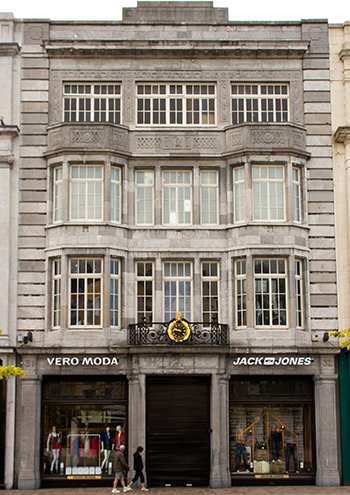Egan’s
Published in Gems of Architecture, Issue 6 (November/December 2020), Volume 2831–32 St Patrick’s Street, Cork
By Pat Ruane
 The burning of Cork by Crown forces on the night of 11–12 December 1920 had a devastating impact on the economic heart of the city, as the fire swept through St Patrick’s Street. A series of atmospheric photographs taken by the International Newsreel Corporation in the immediate aftermath of the conflagration shows small crowds of onlookers standing among the ruins. A smoking pile of debris, framed by the crumbling façades of Sunner’s Dispensing Chemist and Forrest & Sons, was all that remained of the premises of Wm. Egan & Sons, the city’s pre-eminent silversmiths, who began trading in Cork in the 1820s, moving to St Patrick’s Street in 1876.
The burning of Cork by Crown forces on the night of 11–12 December 1920 had a devastating impact on the economic heart of the city, as the fire swept through St Patrick’s Street. A series of atmospheric photographs taken by the International Newsreel Corporation in the immediate aftermath of the conflagration shows small crowds of onlookers standing among the ruins. A smoking pile of debris, framed by the crumbling façades of Sunner’s Dispensing Chemist and Forrest & Sons, was all that remained of the premises of Wm. Egan & Sons, the city’s pre-eminent silversmiths, who began trading in Cork in the 1820s, moving to St Patrick’s Street in 1876.
The British government at first tried to deflect the blame for the outrage, which was a reprisal against the civilian population for attacks on Crown forces by the IRA; following the Treaty, however, a scheme of compensation payments facilitated the rebuilding of much of the city centre. Many different architectural practices, contractors and craftworkers were involved, and the task of designing a new premises for the notable silversmiths fell to O’Flynn & O’Connor, who exhibited their scheme at the Royal Hibernian Academy in 1924. The same partnership designed the slightly later City Library (1927–30) in Grand Parade (HI 20.1, Jan./Feb. 2012, p. 45). Both buildings owe much to contemporary developments in civic and commercial architecture at home and abroad; concrete and steel substructures were not only cost-effective and reasonably quick to build but, crucially, given the reasons for the reconstruction, largely resistant to fire.
Egan’s presents a well-mannered four-storey façade of silver-grey Cork limestone framed by vigorously channelled giant piers. A strict symmetry carries through from street level to roof. The shop front combines the fluted pilasters and dentilated cornice of the Classical age with geometric glazing in the spirit of the emerging Modern movement. Two-storey polygonal bays jutting out over the display windows finish in parapets-cum-balconettes where low-relief knotwork sees a device from the Celtic period resurrected as part of the identity of a new era of hope and prosperity for Cork. A looser knotwork frames the windows of the uppermost floor before Classicism takes over again in a blank parapet lacking the balustrades and curlicues of its immediate neighbours.
In its heyday, the interior was a theatrical setting for the display of the silversmith’s craft. The pillared shop, which covered the first two floors, featured bespoke timber counters and display cases. Cork’s young lovers could enjoy a touch of Hollywood glamour as they ascended and descended the elegantly bifurcating staircase.
Egan’s celebrated its centenary in St Patrick’s Street in 1976 but closed its doors for the last time ten years later on 11 October 1986. The premises are now occupied by a multinational retailer, but the brightly gilded clock face over the shop front serves as a perpetual reminder that this was once the finest establishment in Cork for jewels, silverware and timepieces.
Pat Ruane is Architectural Conservation Officer, Cork City Council. Series based on the NIAH’s ‘building of the month’, www.buildingsofireland.com.
















